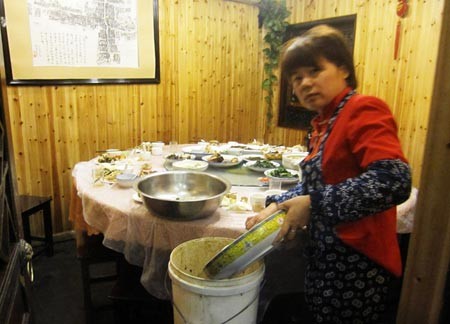University Professor Uses Leftovers To Produce Biocoal
| Acsilyn Miyazaki | | May 19, 2014 01:26 PM EDT |
(Photo : Photo/CFP) A restaurant employee dumping leftover food.
A Sichuan University scholar has created biocoal out of leftover food.
The WCC Daily reported that the university scholar found out that leftover food can be used to create biocoal for electricity, a source that provides more energy per kilo than that which is present in coal used within electric plants.
Like Us on Facebook
The scholar coming from the college of architecture and environment in the university, Lu Hongyan, came up with the idea to use a ton of leftover food.
He turned it into 80 to 120 kilograms of biocoal which was also reviewed and approved by a total of seven experts. The approval was given on April 29, from experts in and outside the province.
Lu used three pieces of equipment, one of which he imported from Germany, to make the biocoal. He spent CNY300000 for the imported hypothermal carbonizer.
Other equipment used included the electric drum wind drying oven and a re-wired vacuum pump.
The process of turning the leftover food into biocoal was demonstrated by the laboratory staff members of the professor.
They placed the leftovers into the hypothermal cabonizer and baked between one to four hours.
The process turned the leftover food into a black, porridge looking substance. After which, the staff members placed the substance into the pump to remove 90 percent of the water and placed it into the oven until results showed something which looked like the soil.
According to Lu, his research staff found out that the optimal time needed to process the leftovers lasted 1 and a half hour inside the carbonizer.
Furthermore, he said that the watery result could be dried at room temperature if necessary.
Professor Lu stated that the process can turn between 40 percent and 60 percent of the leftover food into burnable biocoal.
His research also showed that biocoal could make 6,630 to 7,730 calories of electricity per kilo.
This was higher than the regular coal used for electricity production which was only recording to be at 4,800 to 5,500 calories.
Lu was motivated to conduct the research following the waste recycle system in Germany. He said that he intends to build a factory that could process bigger amounts of leftover food after getting approval.
©2015 Chinatopix All rights reserved. Do not reproduce without permission
EDITOR'S PICKS
-

Did the Trump administration just announce plans for a trade war with ‘hostile’ China and Russia?
-

US Senate passes Taiwan travel bill slammed by China
-

As Yan Sihong’s family grieves, here are other Chinese students who went missing abroad. Some have never been found
-

Beijing blasts Western critics who ‘smear China’ with the term sharp power
-

China Envoy Seeks to Defuse Tensions With U.S. as a Trade War Brews
-

Singapore's Deputy PM Provides Bitcoin Vote of Confidence Amid China's Blanket Bans
-

China warns investors over risks in overseas virtual currency trading
-

Chinese government most trustworthy: survey
-

Kashima Antlers On Course For Back-To-Back Titles
MOST POPULAR
LATEST NEWS
Zhou Yongkang: China's Former Security Chief Sentenced to Life in Prison

China's former Chief of the Ministry of Public Security, Zhou Yongkang, has been given a life sentence after he was found guilty of abusing his office, bribery and deliberately ... Full Article
TRENDING STORY

China Pork Prices Expected to Stabilize As The Supplies Recover

Elephone P9000 Smartphone is now on Sale on Amazon India

There's a Big Chance Cliffhangers Won't Still Be Resolved When Grey's Anatomy Season 13 Returns

Supreme Court Ruled on Samsung vs Apple Dispute for Patent Infringement

Microsoft Surface Pro 5 Rumors and Release Date: What is the Latest?










